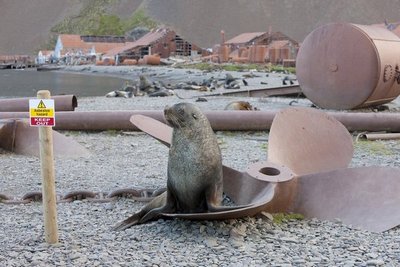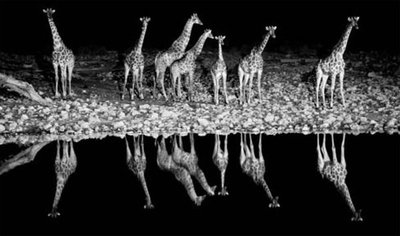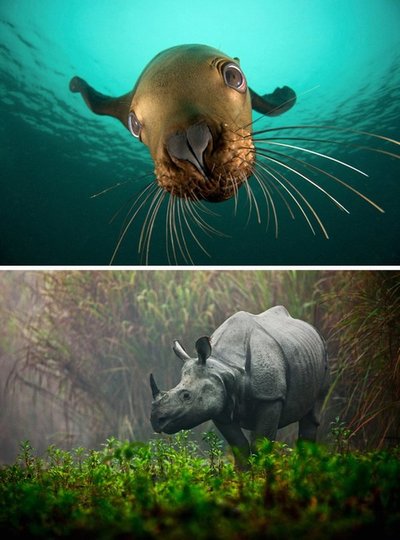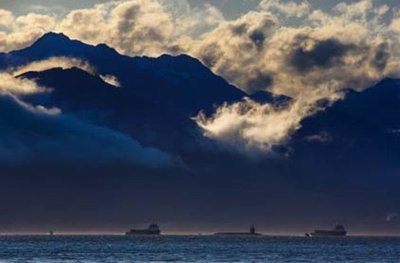June 24, 2010
Visions of the natural world: Award-winning conservation photography at the Burke
Andrew Whiteman is looking at a photograph of Japanese macaque monkeys languishing comfortably in steaming hot pools. It’s a first-place winner for wildlife photography in the 2010 International Conservation Photography Awards (ICPA), which are being exhibited at the Burke Museum through Sept. 6.
Whiteman is uniquely involved in this show as both the Burke’s senior curator of exhibits and designer and one of four judges of the competition, helping to whittle down 1,000 submissions to about 80 final selections. The awards competition was founded by Seattle-based wildlife photographer and author Art Wolfe and continues under his general guidance.
The photo Whiteman is admiring is called Tender Moments: Snow Macaque Family in Hot Onsen, and was taken by Oksana Perkins in Japan’s Joshinetsu Kogen National Park. Whiteman has offered it as an example of the sort of image that may at first seem routine but which richly rewards closer inspection. It’s a lovely image, to be sure — but what makes it a winner? Whiteman thinks a moment before answering.
“A lot of us had seen these monkeys, this particular species in these pools” before, he says. “But when you start to look at the beauty of the gestures, the eye contact, the intimacy, the little touch of the arm and the quality of the composition, it’s beautiful. When we started to look at the overall composition and some of the quality of those details, we all just fell in love with it on a whole new level. We saw this species in its environment new and fresh and it was exciting and it made the grade.”
The image is an example both of fine photography and of what Wolfe likes to see in this competition, Whiteman said: observation and appreciation of the natural world. Wolfe himself talks of the awards on the ICP website. He says he organized the awards with friends in 1997, “the idea being that we wanted to provide a platform from which photographers both amateur and professional alike could showcase their work in a very prestigious way. We love the idea of championing the cause of preservation and nature through the medium of photography.”
Whiteman shared judging duties with three professionals in what he called “a pretty democratic process” of culling the submissions to decide on the winners. They are Barbara Cox, photography consultant; Tim Girvin, journalist and designer, and Cynthia M. Hall of Girvin Strategic Branding; and Jane Perovich, senior photo editor at Getty Images. The judges began with two elimination rounds they did remotely, then met in person for the final selections. “It was a very illuminating process for me. I really enjoyed it — I learned a lot from it.”
The exhibit features extraordinary photos in nine categories created by Wolfe. They are: Landscape, Wildlife, Flora, Underwater, Community at Risk, Natural Environment at Risk, Documenting a Conservation Project, Puget Sound at Risk and a category for photos shot by K12 students under the age of 18 . There will also be a section for photographs chosen personally by Wolfe, with a special Art Wolfe Award for an image that exemplifies his vision of the competition.
Among the striking winning images is a face-to-face underwater view of a sea lion, a seal sitting among the detritus of the former South Georgia whaling station, a view of Death Valley National Park, a hardy plant struggling to survive in the Namib desert, and shafts of light through the forest on a winter morning in the Mount Baker-Snoqualmie National Forest.
Each category has a first and second-place winner as well as honorable mentions. All the photographers submitted artist’s statements, information from which will be posted in captions alongside the image. With photo-altering software easily available, the competition spelled out the modest limits of computer manipulation allowed: “Heavily manipulated images will not be accepted. Color and contrast adjustments, sharpening, burning and dodging, etc. will be accepted within reason so long as it does not alter the subject content of the original image.”
Whiteman says, “What I believe Art Wolfe is trying to do and as judges what we were trying to faithfully help him with, was to select photographs that somehow get people more engaged in conservation issues. To look … with a fresh eye, perhaps that encourages stewardship and a greater respect and appreciation for the natural world around us.”
Whiteman said his own hope is the International Conservation Photography Awards exhibit leads to more people seeing photography as a way of communicating around environmental issues. “It’s an extremely powerful tool for energizing people’s opinions.”
For more information about the Burke Museum of Natural History and Culture, visit online at www.burkemuseum.org.






